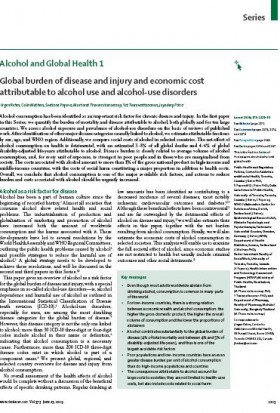This website uses cookies so that we can provide you with the best user experience possible. Cookie information is stored in your browser and performs functions such as recognising you when you return to our website and helping our team to understand which sections of the website you find most interesting and useful.
Global burden of disease and injury and economic cost attributable to alcohol use and alcohol-use disorders. (2009)

รายละเอียดเพิ่มเติม
Global burden of disease and injury and economic cost attributable to alcohol use and alcohol-use disorders.
Rehm J1,2,3,4 Mathers C5 Popova S1,2,6 Thavorncharoensap M7,8 Teerawattananon Y7 Patra J1
1 Public Health and Regulatory Policies, Centre for Addiction and Mental Health, Toronto, Canada
2 Dalla Lana School of Public Health, University of Toronto, Toronto, Canada
3 WHO Collaboration Centre for Substance Abuse, Zurich, Switzerland
4 Epidemiological Research Unit, Klinische Psychologie und Psychotherapie, Technische Universität Dresden, Dresden, Germany
5 WHO, Department of Health Statistics, Geneva, Switzerland
6 Factor-Inwentash Faculty of Social Work, University of Toronto, Toronto, Canada
7 Health Intervention and Technology Assessment Program (HITAP); Ministry of Public Health, Nonthaburi, Thailand
8 Department of Pharmacy, Faculty of Pharmacy, Mahidol University, Bangkok, Thailand
Introduction
Public Health and Regulatory Policies, Centre for Addiction and Mental Health, Toronto, Canada; Dalla Lana School of Public Health, University of Toronto, Toronto, Canada; WHO Collaboration Centre for Substance Abuse, Zurich, Switzerland; Epidemiological Research Unit, Klinische Psychologie und Psychotherapie, Technische Universität Dresden, Dresden, Germany.
Alcohol consumption has been identified as an important risk factor for chronic disease and injury. In the first paper in this Series, we quantify the burden of mortality and disease attributable to alcohol, both globally and for ten large countries. We assess alcohol exposure and prevalence of alcohol-use disorders on the basis of reviews of published work. After identification of other major disease categories causally linked to alcohol, we estimate attributable fractions by sex, age, and WHO region. Additionally, we compare social costs of alcohol in selected countries. The net effect of alcohol consumption on health is detrimental, with an estimated 3.8% of all global deaths and 4.6% of global disability-adjusted life-years attributable to alcohol. Disease burden is closely related to average volume of alcohol consumption, and, for every unit of exposure, is strongest in poor people and in those who are marginalised from society. The costs associated with alcohol amount to more than 1% of the gross national product in high-income and middle-income countries, with the costs of social harm constituting a major proportion in addition to health costs. Overall, we conclude that alcohol consumption is one of the major avoidable risk factors, and actions to reduce burden and costs associated with alcohol should be urgently increased.
Link: http://www.ncbi.nlm.nih.gov/pubmed/19560604?ordinalpos=1&itool=EntrezSystem2




